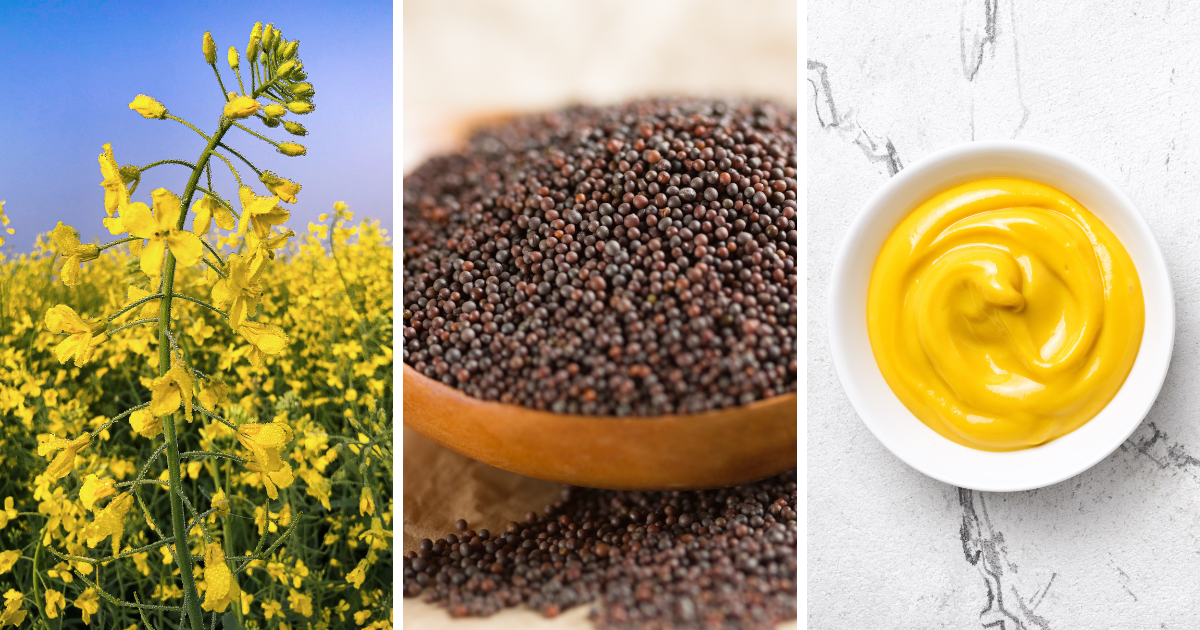
This is what you can expect in our article on the topic American mustard:
- American Mustard – what is it actually?
- American mustard: Difference to German mustard
- Mustard history – who invented mustard and where was mustard invented?
- Mustard production: How mustard is made
- 10 impressive facts about (American) mustard
Not all mustards are the same. There are now a variety of different types of mustard . In addition to the French Dijon mustard , the Bavarian sweet mustard , the English mustard and many other, partly regional mustard creations, there is probably the most popular hot or spicy mustard in Germany. medium-hot mustard – and the American mustard . The latter, the American Mustard , we will take a closer look in this article. We will clarify important questions about American mustard, what the Differences are where mustard is comes from and how Mustard made Finally, we have some more Facts about mustard that you definitely don't know yet.
American Mustard – what is it actually?
The American mustard, which is also known in this country as American Mustard is not only a special taste. Characteristic of American mustard is its milder and slightly sweet taste . It also stands out visually from other mustard varieties. Due to the ground mustard seeds and the addition of a higher amount of turmeric American mustard receives a bright yellow color . This intense yellow tone is also the reason why American mustard is often called Yellow Mustard However, Americans themselves simply call it mustard. Compared to the medium-hot mustard we are familiar with, American mustard is less sharp and slightly milder. However, the American Mustard makes up for the lack of spiciness with its unique aroma and the pleasant taste The mustard is a classic American favorite, and goes perfectly with hot dogs and burgers. It also adds a unique flavor to meat and fish. Even sauces, dressings, and dips can be flavored with the mustard. American Mustard be refined.
Next to the traditional American Mustard There are also some in the USA Delicatessen companies that use American mustard reinterpreted and have created their own unique mustard creations – especially the specialty manufacturer Stonewall Kitchen from Maine. We've sampled the various creations and imported a diverse selection of the most delicious mustards for you:
- Truffle Mustard (an aromatic experience of mustard and truffle)
- Roasted Garlic Mustard (spicy mustard with roasted garlic and a hint of honey)
- Spicy Honey Mustard (spicy mustard refined with exquisite honey)
- Sweet Honey Mustard (intense, sweet honey mustard)
- Caramelized Onion Mustard (fine mustard with caramelized onions)
- Blue Cheese Herb Mustard (aromatic herb mustard with tasty blue cheese)
- Raspberry Honey Mustard Dipping Sauce (French Dijon mustard with fruity raspberries)
Tip: If you also Grilling or at BBQ not on the typical mustard taste want to do without, then definitely try the KC Gold Mustard BBQ Sauce by Rufus Teague from the BBQ stronghold of Kansas City. The reason for the exceptionally high quality and excellent taste of the American mustard sauce lies in the Production . Only the best and purely natural ingredients In addition, the ingredients are cooked for a much longer time, which Taste intensified becomes.
Speaking of barbecue… Did you know that the Barbecue tradition in South Carolina, to use spicy mustard sauces (instead of the classic vinegar and tomato-based sauces), on German immigrants Between 1730 and 1750, many Germans in the West of the US state where they preferred to operate small farms instead of large plantations – just like they knew from home. In addition, the German immigrants brought their Groceries and culinary customs to the United States. The greatest success was the import of Mustard , which is the barbecue tradition in South Carolina significantly influenced and continues to shape it today.
American mustard: Difference to German mustard
Some differences between American mustard and German mustard. We are happy to summarize the most important differences once again for you. While German table mustard is usually medium-spicy is, the American Mustard rather with a milder taste and slightly sweet notes. This is also the reason why American mustard – compared to medium-hot mustard – is larger selection of dishes In American cuisine, it is therefore not without reason considered a true all-rounder and is now an indispensable part of many households.
Tip: If you still like the popular German table mustard too spicy then be sure to try American mustard as an alternative.
The two mustard varieties also have slight differences in color. American mustard has a intense , almost bright yellow tone . German mustard, on the other hand, is somewhat darker. The table mustard known here is characterized by a rather darker, rich yellow tone with shades of brown.
Mustard history – who invented mustard and where was mustard invented?
If you are looking for an answer to the question, who invented mustard has or where mustard was invented To understand the origin of mustard, one has to look back several millennia. The history of mustard begins around 1,000 years before Christ and is therefore about 3,000 years old. ancient China The first evidence of the existence of mustard can be found in the historical Egypt Mustard was already used as a medicinal remedy. Roman campaigns The first mustard seeds found their way to Asia and Europe, but initially it was predominantly as medicine The Greek physician Pedanios Dioscorides described in the first century AD the healing effect of mustard. Around the same time, the Romans discovered the strong seasoning power of mustard and later adopted the knowledge of the Greeks and used mustard as a medicine. Around 300 years later, the first traditional mustard recipe , which consisted of crushed mustard seeds, olive oil, vinegar and honey.
The triumph of mustard began when the mustard made its way over the Alps to Central Europe At the end of the eighth century, Charlemagne, King of the Frankish Empire, ordered the Mustard cultivation in Germany officially. In the 14th century French dukes the foundation for the rise of the now well-known Dijon mustard by being the first strict quality guidelines for mustard.
To this day, mustard is considered one of the most most widely distributed , cultivated and used spices – and the worldwide .
Mustard production: How mustard is made
For the Production of mustard In addition to the ingredients, one thing is needed above all: Time . Although today many production steps modernized mustard production still takes some time. This also applies to the production of American mustard . In the first step of mustard production, the basic ingredient, the Mustard seeds The mustard seeds (also called mustard grains) are found in the pods of the mustard plant. Each pod contains approximately ten mustard seeds. Once the pods are ripe, the required mustard seeds are extracted from the pods. This step in the mustard production is usually carried out by the producer, i.e. the person who Mustard plants cultivates.
After the mustard seeds have been separated from the pods, they must be placed in a thoroughly cleaned using a complex process Before the cleaned mustard seeds can be further processed, they are usually a few weeks stored in tanks. In the further course of mustard production, the stored mustard seeds are rolled using large rollers crushed, deoiled and to very fine mustard flour (or mustard meal) This process breaks up the individual seeds, which essential oils After the mustard seeds have been ground to a flour-like powder, the important basic ingredients such as Water, salt, vinegar and other spices This mixture is then stirred in the mash tun at room temperature until the so-called "Mash" By the way: By grinding the mustard seeds in the previous step, the surface of the single mustard seed enlarged so that the individual grains in the mash tank swell faster can.
In the next stage of mustard production, the pulp-like mash is gentle process once again fine Some mustard producers repeat the process one more time or several times. To prevent the mustard from getting too hot, it is heated cooled down . By grinding the mash, the liquid ingredients (water and vinegar) form a permanent bond with the spices and mustard flour, so that the familiar, creamy consistency of the mustard. However, the mustard production is not yet complete. Before the mustard can be bottled and sold, it is stored in large tanks vented and matures between 1 and 14 days, so that it Fully develop the aroma can.
As already mentioned, the frequency of grinding the mash varies from producer to producer. used mustard seeds There are differences. hotter mustard varieties in production more dark mustard seeds , i.e. black and brown mustard seeds, are used. If the mustard should have a milder be, the proportion of white mustard seeds significantly higher. In principle, one can say: the darker the mustard seed, the hotter and spicier the mustard will be during production.
10 impressive facts about (American) mustard
- On the first Saturday in August, the National Mustard Day celebrated
- According to Pythagoras, mustard not only improves food but also Sharpen your mind
- In Wisconsin in the USA there is the National Mustard Museum, a Mustard Museum with over 6000 types of mustard
- Mustard can not go bad – it may only lose some of its sharpness and aroma after the best before date has been reached
- Mustard is one of the most popular and most commonly used spices of the world
- Mustard belongs to the cruciferous plant family and is therefore Related to broccoli
- The word mustard has a Latin origin
- Mustard is one of the 14 allergens that must be specially labelled as an ingredient on food in the EU
- In Germany, average per capita consumption in 2021 was around 850 grams of mustard
- All parts of the mustard plant are edible – also leaves, seeds and flowers


